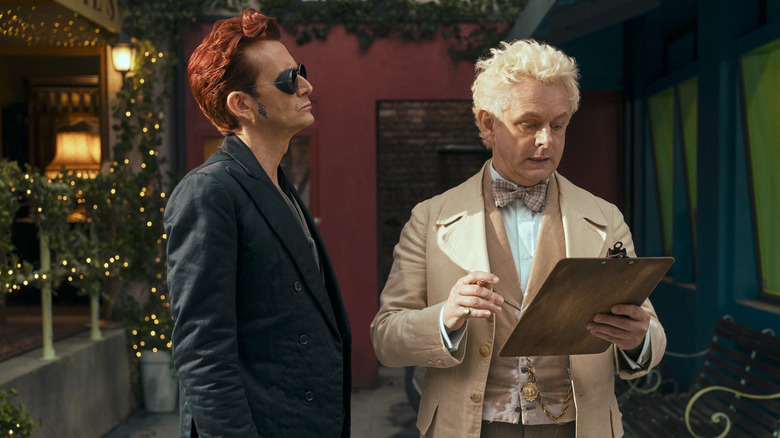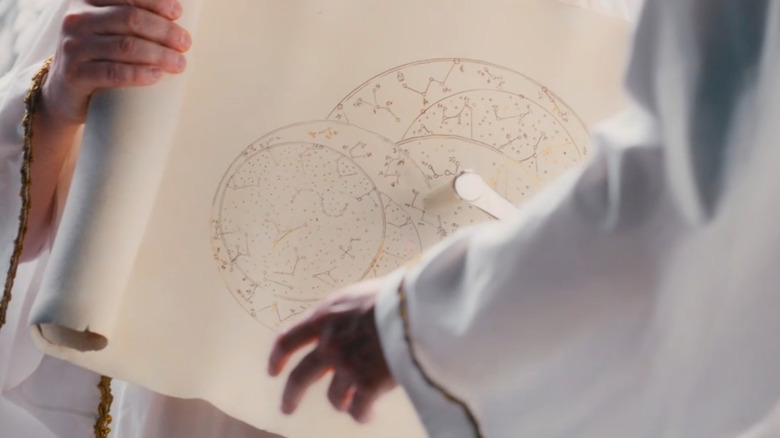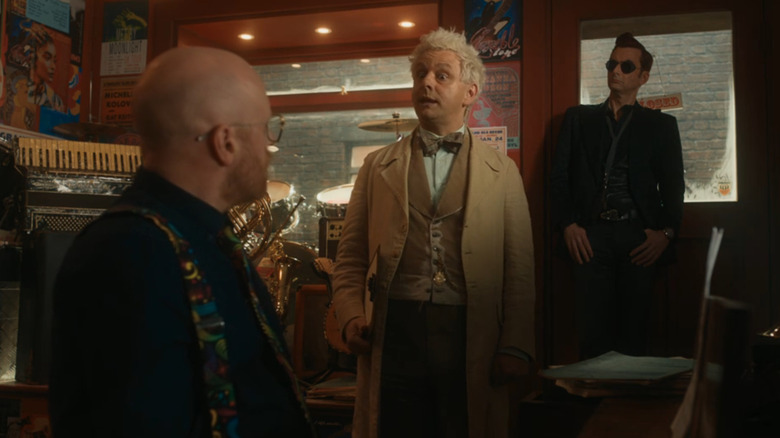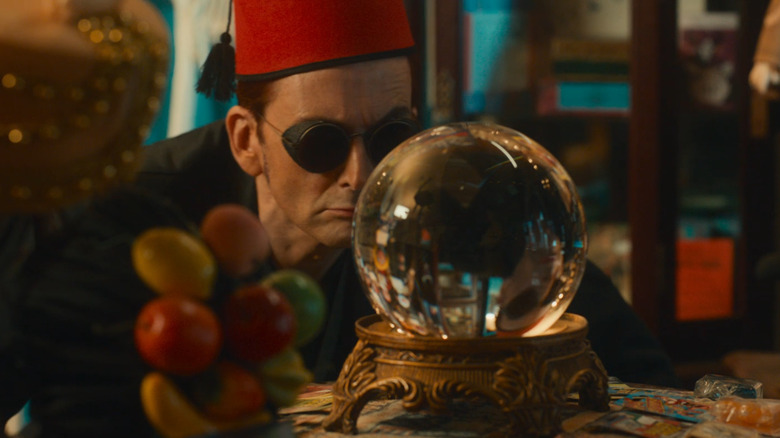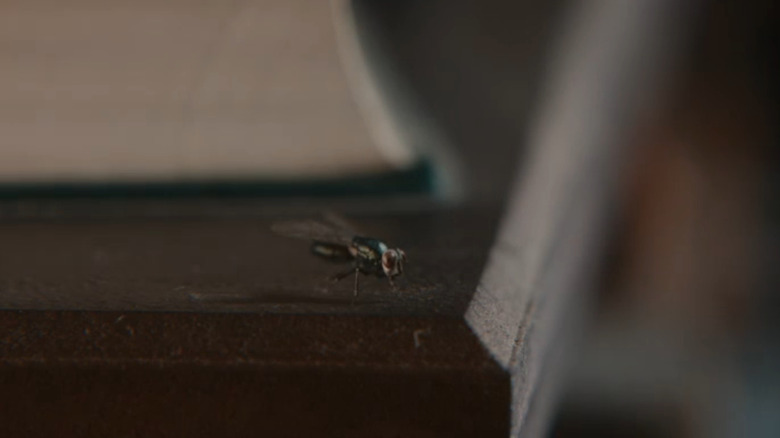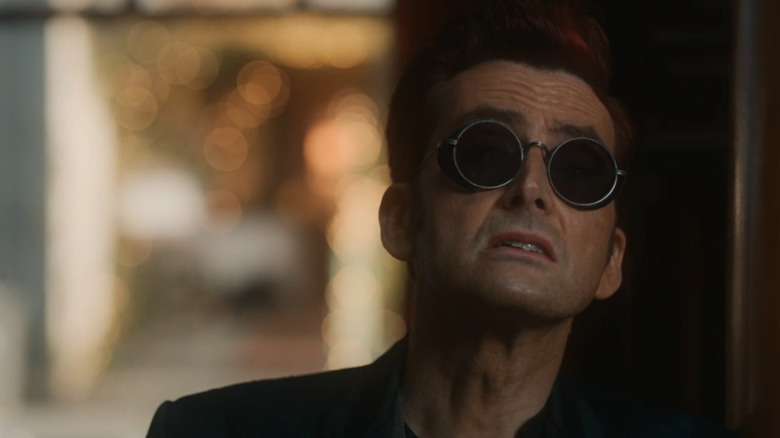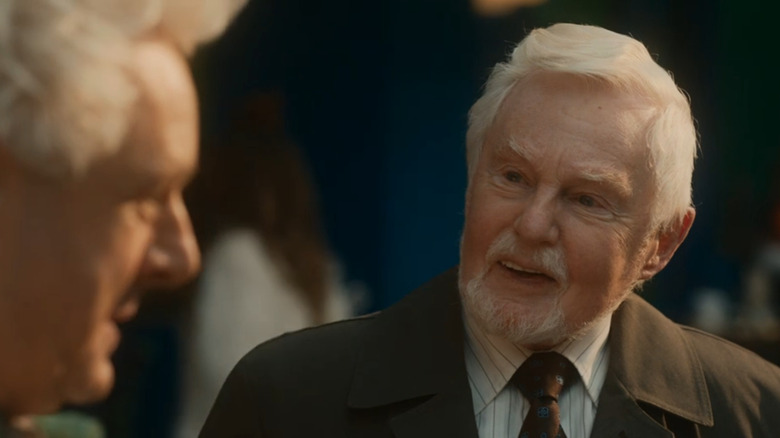All The Doctor Who Easter Eggs You Missed In Good Omens 2
This article contains nice and accurate spoilers for "Good Omens 2"
One thing you may not be thinking about as you binge the brand-new second season of "Good Omens" on Amazon Prime is "Doctor Who," the beloved BBC science fiction series. But the two are far more connected than you might have realized, and showrunner Neil Gaiman has packed "Good Omens 2" full of Easter eggs.
"Good Omens" stars former "Doctor Who" icon David Tennant as the demon Crowley. Tennant, of course, played The Tenth Doctor for several seasons of the beloved BBC series. He is joined by Michael Sheen as the angel Aziraphale. Not only that, but "Good Omens 2" is created and written by Neil Gaiman, whose connections to the historic science-fiction series run deep. Not only is Gaiman a lifelong fan of "Doctor Who," but he also penned two of its episodes, "The Doctor's Wife" and "Nightmare in Silver." The former of the two episodes even featured Sheen in voiceover as a demonic entity. And "Good Omens" director Douglas Mackinnon has directed multiple episodes of The Doctor's exploits.
Accordingly, Gaiman has packed Season 2 of "Good Omens" full of "Doctor Who" Easter eggs for fans to discover. As Sheen told Inverse, "There's not a scene that there isn't something going on in there." While not every scene contains a "Doctor Who" reference, there's plenty to unpack, so here are the Easter eggs we've noticed so far.
The universe's blueprint is written in something close to Gallifreyan
In the opening scene of "Good Omens" Season 2, Episode 1, we find out that Crowley has been tasked with the creation of the universe. Reading from a celestial scroll, he gives the command, "Let there be light," setting into motion the big bang. The contents of the scroll are only visible for a few moments, but it's obvious that the heavenly language printed on it is comprised of interlocking circles. On any other show, this might not be noteworthy, but given the many "Doctor Who" Easter eggs hidden throughout "Good Omens," it's clearly a reference to the fictional language of Gallifreyan spoken by the Doctor and other Time Lords.
Gallifreyan, the language of the Time Lords' home planet, Gallifrey, has been depicted many times on "Doctor Who." The Gallifreyan alphabet, when written out, looks like a series of interlocking circles. The language written in Crowley's blueprint for the universe is too similar for it to be a coincidence. However, it is clearly not actual Gallifreyan. The symbols are filled with star charts.
However, Season 1 of "Good Omens" revealed that the planet Gallifrey does exist in-universe. When Crowley is looking for another planet to hide out on while the Apocalypse begins on Earth, he peruses a book that lists all of the planets. Among them, we can see Gallifrey.
Aziraphale trades a rare Doctor Who book
While trying to round up all the local shopkeepers to attend a meeting, Aziraphale will do anything to get them to show up, even if it means parting with some of his rare books. While courting the proprietor of a music shop, who happens to be a "Doctor Who" fan, Aziraphale bribes him into coming to the meeting by offering him a copy of the 1965 "Doctor Who Annual." It's not so much an Easter egg as it is a direct reference.
The shop owner replies that there was no 1965 "Doctor Who Annual," and he is, in fact, correct. The "Doctor Who Annual" was a compendium of comics, fiction, and more "Doctor Who" themed material, published as a hardback by the BBC each year from 1965 to the present day, excepting gaps from 1987 to 1991 and 1996 to 2005. Since the series was rebooted in 2005, an "Annual" has been printed each year once more. However, the first "Doctor Who Annual," though released in 1965, is the 1966 version.
Aziraphale, of course, is an angel capable of miracles, and he reveals that, although there was no 1965 "Doctor Who Annual" due to problems at the BBC, he is in possession of the only proof copy in existence. The promise of the rare edition is enough to entice the shopkeeper to attend Aziraphale's meeting.
Crowley wears a fez
The fez, a type of cylindrical, flat-topped hat invented during the Ottoman Turkish period, has played a recurring role on "Doctor Who." Over the years, many Doctors have worn the tasseled garment. Although the Second Doctor (Patrick Troughton) voiced his desire to wear a fez, the first to actually do so was the Seventh Doctor (Sylvester McCoy). However, the fez is most closely associated today with the Eleventh Doctor (Matt Smith), who made a habit of incorporating it into his wardrobe.
While David Tennant never wore a fez during his celebrated time as the Tenth Doctor, he dons one in Episode 5 of "Good Omens 2." While Aziraphale bargains with the local shopkeepers to attend his neighborhood meeting, Crowley tags along. They enter a local magic shop, and while Aziraphale sweet talks the owner with the promise of a rare card trick book, Crowley finds himself distracted by a bright red fez, which he promptly puts on. Though he leaves it in the shop, the moment is clearly a callback to the running fez joke in "Doctor Who."
Beelzebub's fly is bigger on the inside
In the final episode of "Good Omens 2," it is revealed that the archangel Gabriel (Jon Hamm) has fallen in love with the demon Beelzebub (Shelley Conn). In fact, Beelzebub has been helping him all along and gave him a magical fly in which to store his memories. When Beelzebub offers it to him, the ruler of Hell notes, "It's a container. It's bigger on the inside."
Even the most casual "Doctor Who" fans will no doubt clock the reference. The Doctor almost unfailingly says the same thing to anyone entering the TARDIS for the first time. The Doctor's TARDIS time machine is much bigger than a fly on the outside, as it resembles an old-fashioned British police call box, but it is dimensionally transcendental, meaning it has more than enough room for those who travel with The Doctor. As The Doctor is fond of saying, "It's bigger on the inside."
Alpha Centauri
In the final episode of "Good Omens 2," two characters who have fallen in love try to figure out a place to go live out their existences together. Crowley chimes in, suggesting, "You know, Alpha Centauri is nice. Always wanted to go there." There are actually three layers to that line of dialogue. The planet Alpha Centauri does exist. It's the closest star system to our own. But in referencing it, Crowley is also calling back to a similar line from Season 1 of "Good Omens," in which he pleads with Aziraphale to run away from Earth with him. In that moment, Crowley also suggests Alpha Centauri.
But while the line is directly relevant to the plot of "Good Omens," it's also a sly reference to the "Doctor Who" character named Alpha Centauri — a one-eyed, genderless alien known to be an ally of The Doctor. Their first appearance came in the 1972 serial "The Curse of Peladon," but they have appeared as recently as 2017 on the main "Doctor Who" series, as well as in a pair of audio episodes from the "Peladon" anthology in early 2022.
Derek Jacobi is Metatron
The appearance of esteemed Shakespearean stage actor Derek Jacobi in "Good Omens 2" is not exactly an Easter egg or reference. However, his inclusion in a show crammed full of so many other such allusions to "Doctor Who" is notable. Jacobi appeared in the "Doctor Who" episode "Utopia," where he played The Doctor's archnemesis, The Master, opposite David Tennant as the Tenth Doctor. He had previously played the character in several official webcasts and audio dramas.
On "Good Omens," Jacobi guest stars in the final episode as the angel Metatron, the voice of God. The role represents another on-screen "Doctor Who" reunion, but there's another parallel dynamic at work, too. As a demon, Crowley is diametrically opposed to Metatron, just as the two were in their roles as The Doctor and The Master. But whereas his nemesis stole the TARDIS in the "Doctor Who" episode they shared, Jacobi's character takes something much more precious to Tennant's character this time around.
